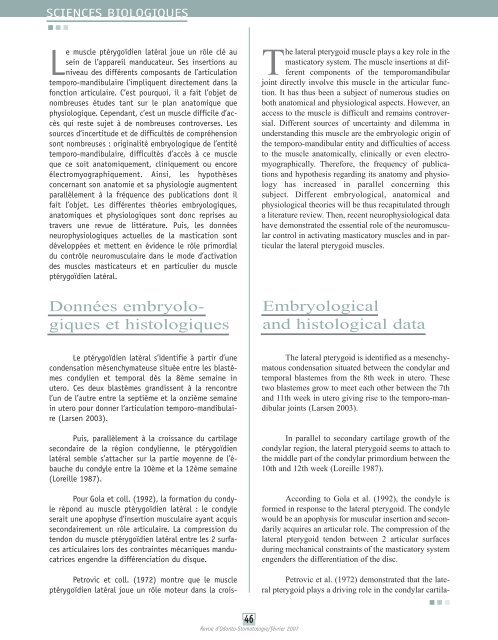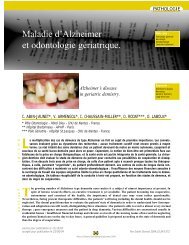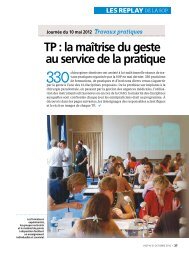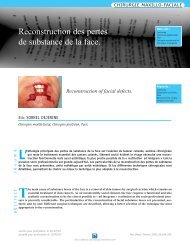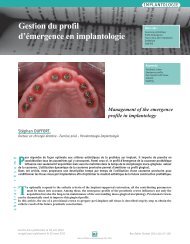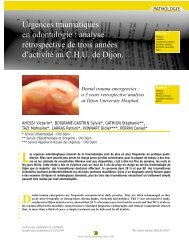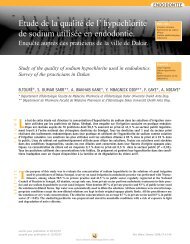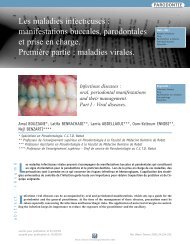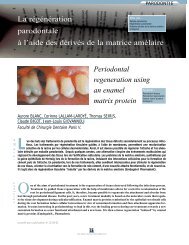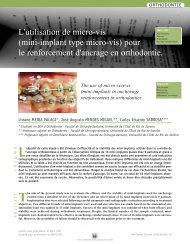Lateral pterygoid muscle - SOP
Lateral pterygoid muscle - SOP
Lateral pterygoid muscle - SOP
Create successful ePaper yourself
Turn your PDF publications into a flip-book with our unique Google optimized e-Paper software.
SCIENCES BIOLOGIQUESLe <strong>muscle</strong> ptérygoïdien latéral joue un rôle clé ausein de l’appareil manducateur. Ses insertions auniveau des différents composants de l’articulationtemporo-mandibulaire l’impliquent directement dans lafonction articulaire. C’est pourquoi, il a fait l’objet denombreuses études tant sur le plan anatomique quephysiologique. Cependant, c’est un <strong>muscle</strong> difficile d’accèsqui reste sujet à de nombreuses controverses. Lessources d’incertitude et de difficultés de compréhensionsont nombreuses : originalité embryologique de l’entitétemporo-mandibulaire, difficultés d’accès à ce <strong>muscle</strong>que ce soit anatomiquement, cliniquement ou encoreélectromyographiquement. Ainsi, les hypothèsesconcernant son anatomie et sa physiologie augmententparallèlement à la fréquence des publications dont ilfait l’objet. Les différentes théories embryologiques,anatomiques et physiologiques sont donc reprises autravers une revue de littérature. Puis, les donnéesneurophysiologiques actuelles de la mastication sontdéveloppées et mettent en évidence le rôle primordialdu contrôle neuromusculaire dans le mode d’activationdes <strong>muscle</strong>s masticateurs et en particulier du <strong>muscle</strong>ptérygoïdien latéral.Données embryologiqueset histologiquesThe lateral <strong>pterygoid</strong> <strong>muscle</strong> plays a key role in themasticatory system. The <strong>muscle</strong> insertions at differentcomponents of the temporomandibularjoint directly involve this <strong>muscle</strong> in the articular function.It has thus been a subject of numerous studies onboth anatomical and physiological aspects. However, anaccess to the <strong>muscle</strong> is difficult and remains controversial.Different sources of uncertainty and dilemma inunderstanding this <strong>muscle</strong> are the embryologic origin ofthe temporo-mandibular entity and difficulties of accessto the <strong>muscle</strong> anatomically, clinically or even electromyographically.Therefore, the frequency of publicationsand hypothesis regarding its anatomy and physiologyhas increased in parallel concerning thissubject. Different embryological, anatomical andphysiological theories will be thus recapitulated througha literature review. Then, recent neurophysiological datahave demonstrated the essential role of the neuromuscularcontrol in activating masticatory <strong>muscle</strong>s and in particularthe lateral <strong>pterygoid</strong> <strong>muscle</strong>s.Embryologicaland histological dataLe ptérygoïdien latéral s’identifie à partir d’unecondensation mésenchymateuse située entre les blastèmescondylien et temporal dès la 8ème semaine inutero. Ces deux blastèmes grandissent à la rencontrel’un de l’autre entre la septième et la onzième semainein utero pour donner l‘articulation temporo-mandibulaire(Larsen 2003).Puis, parallèlement à la croissance du cartilagesecondaire de la région condylienne, le ptérygoïdienlatéral semble s’attacher sur la partie moyenne de l’ébauchedu condyle entre la 10ème et la 12ème semaine(Loreille 1987).Pour Gola et coll. (1992), la formation du condylerépond au <strong>muscle</strong> ptérygoïdien latéral : le condyleserait une apophyse d’insertion musculaire ayant acquissecondairement un rôle articulaire. La compression dutendon du <strong>muscle</strong> ptérygoïdien latéral entre les 2 surfacesarticulaires lors des contraintes mécaniques manducatricesengendre la différenciation du disque.Petrovic et coll. (1972) montre que le <strong>muscle</strong>ptérygoïdien latéral joue un rôle moteur dans la crois-The lateral <strong>pterygoid</strong> is identified as a mesenchymatouscondensation situated between the condylar andtemporal blastemes from the 8th week in utero. Thesetwo blastemes grow to meet each other between the 7thand 11th week in utero giving rise to the temporo-mandibularjoints (Larsen 2003).In parallel to secondary cartilage growth of thecondylar region, the lateral <strong>pterygoid</strong> seems to attach tothe middle part of the condylar primordium between the10th and 12th week (Loreille 1987).According to Gola et al. (1992), the condyle isformed in response to the lateral <strong>pterygoid</strong>. The condylewould be an apophysis for muscular insertion and secondarilyacquires an articular role. The compression of thelateral <strong>pterygoid</strong> tendon between 2 articular surfacesduring mechanical constraints of the masticatory systemengenders the differentiation of the disc.Petrovic et al. (1972) demonstrated that the lateral<strong>pterygoid</strong> plays a driving role in the condylar cartila-46Revue d’Odonto-Stomatologie/février 2007


